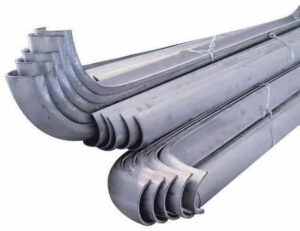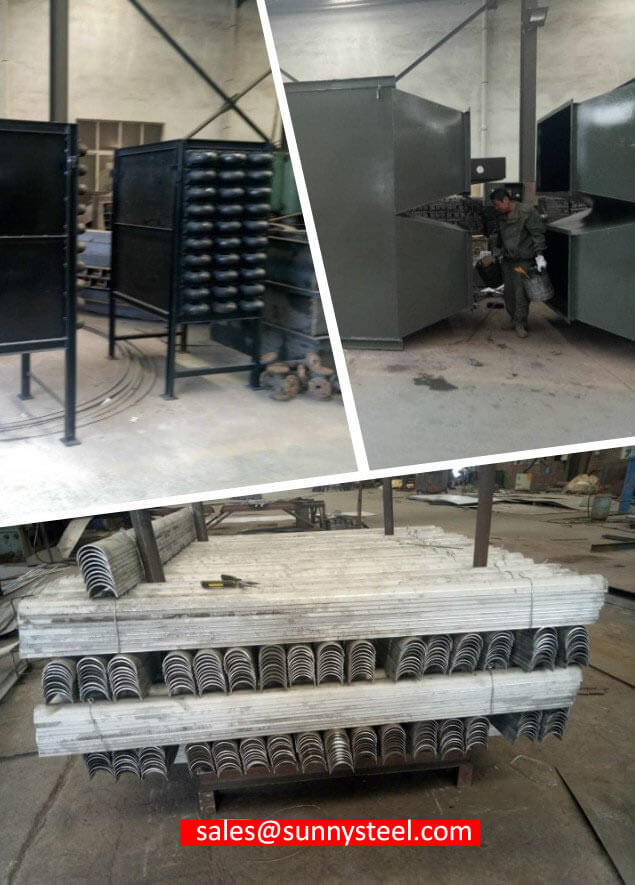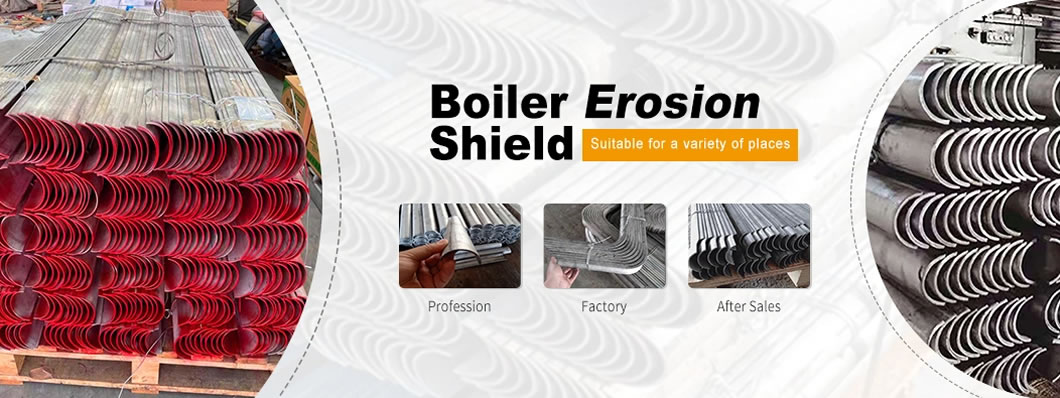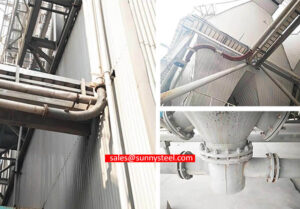Our team is highly trained and experienced in servicing and producing all types of steel supplies. Need help or have a question?
sales@abrasionresistantpipe.com
Tel.: +8621-3378-0199
Our team is highly trained and experienced in servicing and producing all types of steel supplies. Need help or have a question?
sales@abrasionresistantpipe.com
Tel.: +8621-3378-0199

316L anti corrosion and anti wear tube shields are used to reduce excess wear of boiler tubes within the extreme conditions prevalent inside a fossil fuel fired boiler, Sunny Steel is able to manufacture and supply erosion shield solutions to protect and reduce wear in all applicable boiler related situations.
316L anti corrosion and anti wear tube shields are used to reduce excess wear of boiler tubes within the extreme conditions prevalent inside a fossil fuel fired boiler, Sunny Steel is able to manufacture and supply erosion shield solutions to protect and reduce wear in all applicable boiler related situations.
Grade 316 is the standard molybdenum-bearing grade, second in importance to 304 amongst the austenitic stainless steels. The molybdenum gives 316 better overall corrosion resistant properties than Grade 304, particularly higher resistance to pitting and crevice corrosion in chloride environments. 316L is best known among fabricators for being resistant to cracks after the weld process is completed. This makes 316L the preferred choice of fabricators who look to build metallic structures for industry applications.

All these years have enhanced our capabilities and enabled us to produce all kinds of standard tube shield as well as custom snap rings as per customer’s specifications. We have numerous combinations of sizes readily available in large number of stocks and can fabricate custom sizes according to customer’s requirement.
| Grade | Scope | C | Mn | Si | P | S | Cr | Mo | Ni | N |
|---|---|---|---|---|---|---|---|---|---|---|
| 316 | Min | - | - | - | 0 | - | 16 | 2 | 10 | - |
| Max | 0.08 | 2 | 0.75 | 0.045 | 0.03 | 18 | 3 | 14 | 0.1 | |
| 316L | Min | - | - | - | - | - | 16 | 2 | 10 | - |
| Max | 0.03 | 2 | 0.75 | 0.045 | 0.03 | 18 | 3 | 14 | 0.1 | |
| 316H | Min | 0.04 | 0.04 | 0 | - | - | 16 | 2 | 10 | - |
| max | 0.1 | 0.1 | 0.75 | 0.045 | 0.03 | 18 | 3 | 14 | - |

| Grade | Tensile Str | Yield Str 0.2% Proof | Elong | Hardness | |
|---|---|---|---|---|---|
| (MPa) min | (MPa) min | (% in 50mm) min | Rockwell B (HR B) max | Brinell (HB) max | |
| 316 | 515 | 205 | 40 | 95 | 217 |
| 316L | 485 | 170 | 40 | 95 | 217 |
| 316H | 515 | 205 | 40 | 95 | 217 |
| Grade | Why it might be chosen instead of 316? |
|---|---|
| 316Ti | Better resistance to temperatures of around 600-900 °C is needed. |
| 316N | Higher strength than standard 316. |
| 317L | Higher resistance to chlorides than 316L, but with similar resistance to stress corrosion cracking. |
| 904L | Much higher resistance to chlorides at elevated temperatures, with good formability |
| 2205 | Much higher resistance to chlorides at elevated temperatures, and higher strength than 316 |
| 316 | 316L |
|---|---|
| ASTM A240 | ASTM A240 |
| ASTM A666 | ASTM A666 |
| ASME SA240 | ASME SA240 |
| AMS 5524 | AMS 5507 |
 Different types of stainless steel are selected according to the specific conditions of different working conditions. Common materials are: TP321 (Cr18Ni9Ti), TP309S (Cr23Ni13), 1Cr20Ni14Si2, TP310S (Cr25Ni20), 1Cr25Ni20Si2, and some low temperature areas (such as low temperature superheater, low temperature reheater) are made of 1Cr13, 1Cr6Si2Mo and other materials.
Different types of stainless steel are selected according to the specific conditions of different working conditions. Common materials are: TP321 (Cr18Ni9Ti), TP309S (Cr23Ni13), 1Cr20Ni14Si2, TP310S (Cr25Ni20), 1Cr25Ni20Si2, and some low temperature areas (such as low temperature superheater, low temperature reheater) are made of 1Cr13, 1Cr6Si2Mo and other materials.
The boiler was originally designed to be accurate. Different materials have different temperature resistance and mechanical strength. 1Cr13, 1Cr6Si2Mo generally has a temperature resistance of 600 ℃ or less.
| Material(Grade) | Temperature resistance | Yield strength | Tensile strength | Elongation | HB | HRB | HV |
|---|---|---|---|---|---|---|---|
| 1Cr18Ni9Ti | 925 ℃ | ≥205MPa | ≥520MPa | ≥40% | ≤187 | ≤90 | ≤200 |
| Cr23Ni13 | 1095 ℃ | ≥205MPa | ≥520MPa | ≥40% | ≤187 | ≤90 | ≤200 |
| 1Cr20Ni14Si2 | 1095 ℃ | --- | ≥590MPa | ≥40% | --- | --- | --- |
| Cr25Ni20 | 1150 ℃ | ≥205MPa | ≥520MPa | ≥40% | ≤187 | ≤90 | ≤200 |
| 1Cr25Ni20Si2 | 1150 ℃ | --- | ≥540MPa | ≥35% | --- | --- | --- |
Tube shields are custom made to fit perfectly to straight sections, curved sections and even finned and specialised tubing.

Boiler tube erosion shields, also known as anti-corrosion shields, anti-wear plate, anti-wear protection shields, anti-wear cover plate, anti-corrosion cover plate, boiler climbing pipe, anti-wear pressure plate, etc. , which are used in combination with snap rings.
Boiler tube erosion shields are produced using a high-pressure press and professional mould pressing. The production time is short, the welding performance is good, the welding should not fall off, the surface is smooth, and the appearance is beautiful. Boiler tube erosion shields with bends are formed by pressing on a press or bending with a special abrasive on a tube bender.
Boiler tube shields are designed to eliminate major maintenance and downtime costs from boiler and condenser tube failure.
 The service life of boiler tube erosion shields is different in different types of boilers and different use parts. The normal service life is a period of overhaul (3-5 years) for the boiler. Generally, some boilers will be replaced or retrofitted every time the boiler is overhauled. The main replacements are those of the boiler tube erosion shields that are severely thinned and exceeded the standard; those that were not firmly detached during the boiler operation during the previous installation. According to the wear of the boiler tube erosion shields during replacement, if the thickness is severely reduced, it needs to be replaced, the deformation is severe, and those that cannot protect the tube also need to be replaced. In addition, some boiler tubes are not equipped with boiler tube erosion shields, but during the boiler inspection, it is found that the tubes have a tendency to wear and thinning. Generally, boiler tube erosion shields are also installed to prevent further wear of the tubes and cause serious consequences such as boiler explosions.
The service life of boiler tube erosion shields is different in different types of boilers and different use parts. The normal service life is a period of overhaul (3-5 years) for the boiler. Generally, some boilers will be replaced or retrofitted every time the boiler is overhauled. The main replacements are those of the boiler tube erosion shields that are severely thinned and exceeded the standard; those that were not firmly detached during the boiler operation during the previous installation. According to the wear of the boiler tube erosion shields during replacement, if the thickness is severely reduced, it needs to be replaced, the deformation is severe, and those that cannot protect the tube also need to be replaced. In addition, some boiler tubes are not equipped with boiler tube erosion shields, but during the boiler inspection, it is found that the tubes have a tendency to wear and thinning. Generally, boiler tube erosion shields are also installed to prevent further wear of the tubes and cause serious consequences such as boiler explosions.
On the heating surface of superheated and the economizer tube bundle of the boiler, in order to prevent the pipe from being worn by high temperature flue gas washing, boiler tube erosion shields are mostly arranged on the outer side of the pipe in the direction of flue gas flow. The elbow erosion shields solves the abrasion problems of water wall tubes, superheater tubes, economizer tubes and reheater tubes in the furnace, and provides a guarantee for the long-term and reliable operation of CFB boiler. With the increase of CFB boiler products, the type and quantity of the elbow erosion shields will increase.

Tube erosion shields are mainly used on the windward side of the heating surface of the boiler, such as superheaters, reheaters, economizers, and water-cooled wall pipes. The main role is to protect the heating surface of the boiler pipes, reduce pipeline wear, and increase the heating surface of the pipes.

Erosion shields are used to protect boiler tubing from the highly erosive effects of high temperatures and pressures thereby greatly extending tube life.
We offer shielding for tubing, covering straight, bent and finned sections, as well as the clips that hold these in place.
In the long term, these shields more than pay for themselves, preventing the costly replacement of tubing and avoiding the downtime that results from tube breakdown and leaks.
In general, most of them are called “wear-resistant tile” and “wear-resistant cover plate”. Erosion Shields are special boiler accessories.
Generally, most of them are used in power station boilers, small boilers are used less, and some coal chemical industries will also use them.
Need to inquire about our products? Fill out the form below and our staff will be in touch!
Q: How long is your delivery time?
A: The delivery time of customized products is generally 25 35 days, and non customized products are generally shipped within 24 hours after payment.
Q: Do you provide samples? Is it free?
A: If the value of the sample is low, we will provide it for free, but the freight needs to be paid by the customer. But for some high value samples, we need to charge a fee.
Q: What are your payment terms?
A: T/T 30% as the deposit,The balance payment is paid in full before shipment
Q: What is the packaging and transportation form?
A: Non steaming wooden box and iron frame packaging. Special packaging is available according to customer needs. The transportation is mainly by sea.
Q: What is your minimum order quantity?
A: There is no minimum order quantity requirement. Customized products are tailor made according to the drawings provided by the customer.